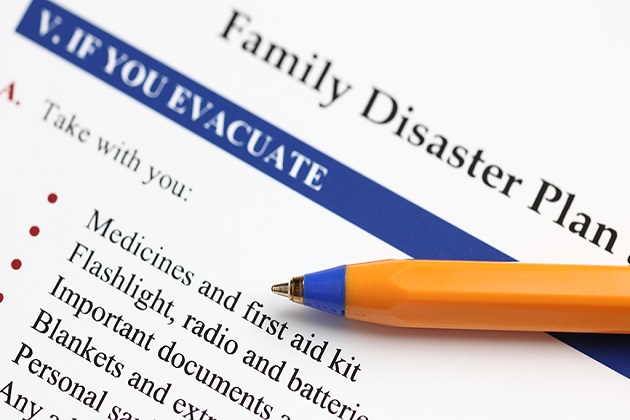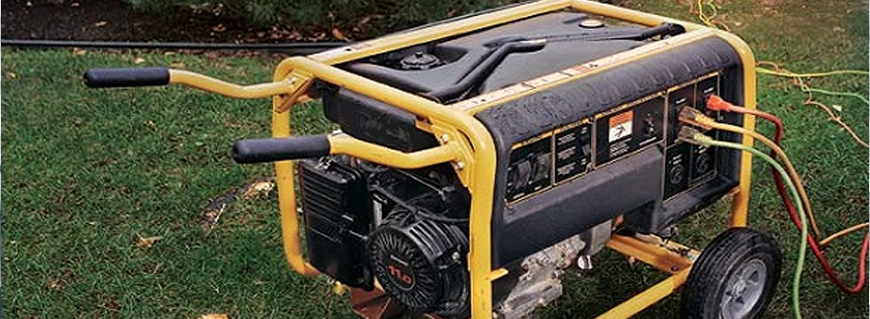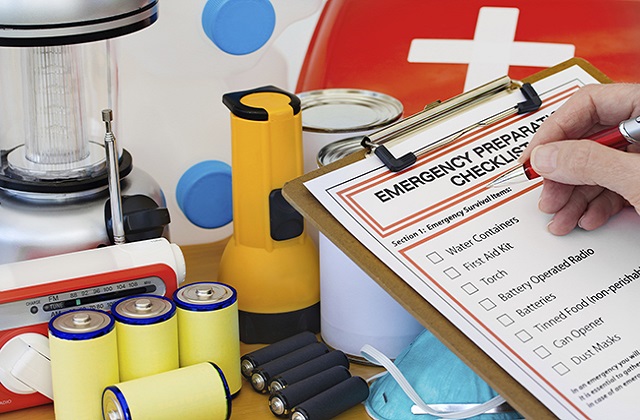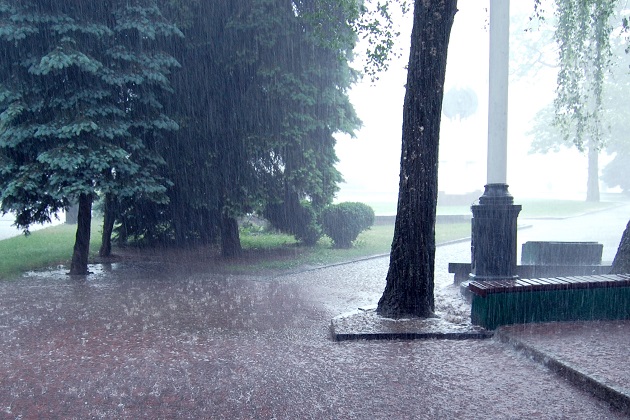 Are you prepared for an emergency? There are many things that you can do in advance to make sure that you and your family have the necessary essentials to sustain you during an emergency.
Are you prepared for an emergency? There are many things that you can do in advance to make sure that you and your family have the necessary essentials to sustain you during an emergency.
Having a go bag packed at all times with emergency supplies and a plan that outlines who you will contact and where you will go if you have to evacuate your home is vital.
Additionally, if you, or someone you know, might require additional assistance to leave home during an emergency, consider registering with the Special Needs Registry. The registry is for individuals with physical or mental disabilities who live on their own. The database will be provided to local municipalities to use in their emergency planning efforts.
Now is also the time to prepare your home and family for hurricanes or severe winter weather, which could include power outages, flooding, or being snowed in at home.
Severe storms could leave you without power for many days, making food storage, food preparation, and how to heat your home all major concerns.
If you plan to use a portable generator as a temporary power source, make sure that you have gasoline or propane on hand to fuel your generator before a storm arrives. It's also extremely important to follow safety guidelines when using a generator, or any other alternate heating source, to protect against Carbon Monoxide poisoning. For safety's sake, be sure to also install at least one carbon monoxide detector near the bedrooms in your home.

During a power outage, a generator can be very useful when it comes to generating your own electricity. However, a generator must be used correctly or it can pose a number of safety hazards. The primary hazards to avoid when using a generator are carbon monoxide (CO) poisoning from the toxic engine exhaust, electric shock or electrocution, and fire or burns.
If you start to feel sick, dizzy, or weak while using a generator, get to fresh air RIGHT AWAY and call 9-1-1. DO NOT DELAY. The carbon monoxide from generators can kill fast.
Follow these safety tips for safe generator use:
- NEVER use a generator inside homes, garages, crawlspaces, sheds, or similar areas, even when using fans or opening doors and windows for ventilation. Deadly levels of carbon monoxide can quickly build up in these areas and can linger for hours, even after the generator has shut off.
- Always follow the instructions that come with your generator. Locate the unit outdoors and far from doors, windows, and vents that could allow CO to come indoors.
- Install battery-operated CO alarms or plug-in CO alarms with battery back-up in your home, according to the manufacturer’s instructions. CO alarms should be certified to the requirements of the latest safety standards (UL 2034, IAS 6-96, or CSA 6.19.01). Test batteries monthly.
- Generators pose a risk of shock and electrocution, especially if they are operated in wet conditions. If you must use a generator when it is wet outside, protect the generator from moisture to help avoid the shock/electrocution hazard, but do so without operating the generator indoors or near openings to any building that can be occupied in order to help avoid the CO hazard. Operate the generator under an open, canopy-like structure on a dry surface where water cannot reach it or puddle or drain under it. Dry your hands, if wet, before touching the generator.
- Never refuel a gas-powered generator while it is running. Turn it off and let it cool because gasoline spilled on hot engine parts can start a fire. Also store extra gasoline properly - not near any potential sources of heat or fire, or inside the house - and in an ANSI-approved container in a cool, well-ventilated place.
- Connect appliances to the generator using heavy-duty extension cords that are specifically designed for outdoor use. Make sure the wattage rating for each cord exceeds the total wattage of all appliances connected to it.
- Use extension cords that are long enough to allow the generator to be placed outdoors and far away from windows, doors and vents to the home or to other structures that could be occupied. Check that the entire length of each cord is free of cuts or tears and that the plug has all three prongs. Protect the cord from getting pinched or crushed if it passes through a window or doorway.
- NEVER try to power the house wiring by plugging the generator into a wall outlet, a practice known as “back-feeding.” This is extremely dangerous and presents an electrocution risk to utility workers and neighbors served by the same utility transformer. It also bypasses some of the built-in household circuit protection devices.
The safest way to transfer power from a generator to your home is to install a transfer switch that will allow you to connect a generator to your home without extension cords. Always use a qualified and licensed electrician when installing electrical control components directly to your home.
For more information, please read these resources:
- Generator Safety Tips That Will Get You Through A Storm And Maybe Save Your Life (Consumer Reports)
- Safe Generator Use (Red Cross)
- Generator Safety Checklist (Ontario County, NY)
- Don't Be Afraid of The Dark (NYSDOH)
- ¡No Quede a Oscuras! (NYSDOH)
Department of Health professionals play a broad role in the annual Emergency Response Preparedness Drill designed to test New York State and Indian Point emergency response plans.
Public Health professionals work closely with Federal, State and County agencies in their efforts to improve emergency response plans for various types of emergencies. These plans are developed under regulations established by the Federal Government to strengthen emergency procedures for areas around nuclear power plants. Although these plans focus on Indian Point, they may be applied to other hazards such as storms, fires, transportation accidents and other emergencies. The four-county Indian Point drill, held in Westchester, Rockland, Orange and Putnam Counties, is evaluated by the Federal Emergency Management Agency (FEMA).
Virtually every department staff member participates in the four-county drill. Public health staff are involved in all phases of the plan which includes planning, training and drill participation as well as public education and information efforts. The Health Department is crucial to the execution of the Indian Point Emergency Response Plan. The Commissioner of Health assists the County Executive in the key decision role in the Operation Center. Department of Health engineers conduct dose assessment and field monitoring functions; public health protection personnel staff the emergency personnel monitoring center; and public health nurses staff the personnel reception centers.
Visit the Emergency Planning for Indian Point Web site for information on how residents should prepare for an emergency.
 Are you and your family prepared?
Are you and your family prepared?
The two key elements to weather safety are to prepare for the risks and to act on those preparations when alerted by emergency officials.
When you know what to do, you and your family can prepare in advance to be ready for any weather emergency.
It is important to understand the difference between a hurricane watch and a hurricane warning. A hurricane watch means that a hurricane may occur within the next 48 hours. A hurricane warning means that hurricane conditions are expected to strike your area within the next 36 hours. Hurricane threats come in many forms, including heavy rainfall, flooding, storm surge, high winds, and tornadoes. Here are some steps to take before a storm hits:
- Make a plan with your family because you may not be together if a disaster strikes.
- Prepare an emergency home kit with the proper supplies.
- Pack a go bag for every member of your household that includes emergency supplies each person would need three (3) days if you had to evacuate.
- Have two weeks' worth of your important medications on hand as a reserve.
- Plan your evacuation route in advance of a storm and practice it with your family.
- Stock up on drinking water and non-perishable goods.
- Have a supply of batteries and be sure you have flashlights and a portable radio that are in good working condition.
- Review how to shut off utilities in an emergency with all family members.
- Close storm shutters and board up all windows.
- Secure all outdoor objects or move them inside.
- Secure your boat or move it to a safer place.
- Fuel your car in case you must leave immediately.
- Fill your home's oil tank and ensure the cap is tight to prevent spills. Above-ground tanks should also be strapped to a secure fixture to prevent tipping in case of flooding.
- If you have a generator or chain saw, fuel it up ahead of time, but operate it only outdoors and away from open windows.
Resources (Preparing for a hurricane)
- How to prepare for a hurricane (Ready.gov)
- When the power goes out (CDC)
- Building an emergency kit (Ready.gov)
- Don't Be Left In The Dark (NYSDOH)
- ¡No Quede a oscuras! (NYSDOH)
- Mobile apps for downloading to Apple, Android and Blackberry devices:
- FEMA
- Red Cross
How to recover from a hurricane
Once the immediate emergency is over, there are a number of steps you should take to ensure your safety. You may want to begin by using a camera so you can take inventory of any storm damage for future damage claims.
Before you enter your home, there are certain important steps you should take. For example, walk carefully around the outside of your home and check for loose power lines and gas leaks, or structural damage to the roof, foundation or chimney cracks. If you have any doubts about safety, have your residence inspected by a qualified building inspector or structural engineer before entering.
In addition, be sure to check for the following inside and outside your home:
- Natural gas - If you smell gas or hear a hissing or blowing sound, open a window and leave IMMEDIATELY. Turn off the main gas valve from the outside, if you can. Call the gas company from a neighbor’s residence or outside on a mobile phone.
- Sparks, broken or frayed wires - If you see sparks or broken or frayed wire or if you smell burning insulation, turn off the electricity at the main fuse box or circuit breaker. If you have to step in water to get to the box or circuit breaker, call an electrician first for advice. Electrical equipment should be checked and dried before being returned to service.
- Water and sewage damage - Flood waters and standing waters pose various risks, including infectious diseases, chemical hazards, and injuries. Limit your contact with flood waters to keep yourself and your family safe. Wash thoroughly with soap and clean water and change clothes as soon as possible if exposed.
- Food - Keeping food safe during and after an emergency, such as a hurricane, Nor'easter, flood, fire, national disaster, or the loss of power is extremely important. If power fails, keep your refrigerator closed as much as possible to help prevent food from spoiling. Throw out all food and other supplies that you suspect may have become spoiled, contaminated or have come into contact with floodwater. During a prolonged power outage, the following foods are potentially hazardous if not stored below 41 degrees Fahrenheit and should be discarded: meat, poultry, seafood, cold cuts, hot dogs, eggs, cream, sour cream, yogurt, milk, custards, puddings, soft and shredded cheeses, cut fruit, cooked vegetables, cooked pasta, casseroles, unbaked cookie and bread dough, gravy, creamy salad dressings, fish sauces, hoisin sauce, opened spaghetti sauce and garlic in oil. Remember, when in doubt through it out.
- Appliances - If appliances are wet, turn off the electricity at the main fuse box or circuit breaker. Then, unplug appliances and let them dry out. Have appliances checked by a professional before using them again.
- Portable Generator - The primary hazards to avoid when using a generator are carbon monoxide (CO) poisoning from the toxic engine exhaust, electric shock or electrocution, fire and burns. Never run generators indoors, including inside garages, basements, crawlspaces and sheds. Get to fresh air right away if you start to feel dizzy or weak and call 9-1-1. Always follow the instructions that come with your generator.
- Space Heaters - Portable space heaters can be helpful as a supplemental source of heat for your home in cold weather. However, space heaters can pose fire and electric shock hazards if not used properly. Fire and electrical dangers can be caused by space heaters without adequate safety features and those placed near flammable materials. Safety must always be a top priority when operating a space heater.
- Chain saws - The potential risk of chain saw injury increases after hurricanes and other natural disasters, when chain saws are widely used to remove fallen or partially fallen trees and tree branches. When possible, it's best to have a chain saw operator who has training and experience in safe chain saw use and cutting techniques to fell and remove limbs from trees. If you must use a chain saw, be certain to operate, adjust, and maintain the saw according to the manufacturer’s instructions. Properly sharpen and lubricate chain saw blades and always choose the proper size of chain saw to match the job. Wear the appropriate protective equipment, which includes a hard hat, safety glasses, hearing protection, heavy work gloves, cut-resistant legwear and boots. Always cut at waist level or below to maintain secure control over the chain saw and take care to avoid contact with power lines. Bystanders or co-workers should remain at least two tree lengths away from anyone felling a tree. If an injury occurs, apply direct pressure to areas of heavy bleeding and call 9-1-1.
- Garbage and Rodents - Garbage invites insects and rodents. After a hurricane, rodents are often looking for food because the storm has destroyed their homes and normal food source. Store your garbage in watertight, rodent/insect-proof containers with tight-fitting covers. If your garbage pick-up has been interrupted, check with your municipality to find out when it will resume.
Resources (After a hurricane)
- How to recover from a hurricane (EPA)
- Food and Water Safety During Power Outages and Floods (FDA)
- Applying for Assistance (Disasterassistance.gov)
 Are you and your family prepared for severe weather?
Are you and your family prepared for severe weather?
The two key elements to weather safety are to prepare for the risks and to act on those preparations when alerted by emergency officials. When you know what to do, you can plan with your household and prepare in advance to be ready. Storm threats come in many forms, including storm surge, high winds, tornadoes, and flooding. Here are some steps to take before the storm hits:
- Prepare your home and stock an emergency home kit.
- Pack a go bag for every member of your household that includes emergency supplies that each person would need if you have to evacuate your home.
- Plan your evacuation route in advance of the storm.
- Have two weeks worth of your important medications on hand as a reserve.
- Close storm shutters and board up all windows.
- Stock up on drinking water and non-perishable goods.
- Have a supply of batteries and be sure you have flashlights and a portable radio in good working condition.
- Review how to shut off utilities in an emergency with all family members.
- Secure all outdoor objects or move them inside.
- Secure your boat or move it to a safer place.
- Fuel your car in case you must leave immediately.
- Fill your home's oil tank and ensure the cap is tight to prevent spills. Above-ground tanks should also be strapped to a secure fixture to prevent tipping in case of flooding.
- If you have a generator or chain saw, fuel it up ahead of time, but operate it only outdoors and away from open windows.
How to recover from a severe storm
Before you begin storm clean up, take inventory with a camera so you can document any damage claims.
Before you enter your home, there are certain important steps to take; walk carefully around the outside and check for loose power lines, gas leaks,structural damage, roof, foundation and chimney cracks. If you have any doubts about safety, have your residence inspected by a qualified building inspector or structural engineer before entering.
Be sure to check for the following inside and outside your home:
- Natural gas - If you smell gas or hear a hissing or blowing sound, open a window and leave immediately. Turn off the main gas valve from the outside, if you can. Call the gas company from a neighbor’s residence.
- Sparks, broken or frayed wires - If you see sparks or broken or frayed wire or if you smell burning installation; turn off the electricity at the main fuse box or circuit breaker. If you have to step in water to get to the box or circuit breaker, call an electrician first for advice. Electrical equipment should be checked and dried before being returned to service.
- Water and sewage damage - Flood waters and standing waters pose various risks, including infectious diseases, chemical hazards, and injuries. By taking certain safety measures you can keep your family safe.
- Food - Keeping food safe during and after an emergency, such as a hurricane, Nor'easter, flood, fire, national disaster, or the loss of power is extremely important. If power fails, keep your refrigerator closed as much as possible to help prevent food from spoiling. Throw out all food and other supplies that you suspect may have become contaminated or come into contact with floodwater. During a prolonged power outage, the following foods are potentially hazardous if not stored below 41 degrees Fahrenheit and should be discarded: meat, poultry, seafood, cold cuts, hot dogs, eggs, cream, sour cream, yogurt, milk, custards, puddings, soft and shredded cheeses, cut fruit, cooked vegetables, pasta, casseroles, unbaked cookie and bread dough, gravy, creamy salad dressings, fish sauces, hoisin sauce, opened spaghetti sauce and garlic in oil. Remember, when in doubt, throw it out.
- Appliances - If appliances are wet, turn off the electricity at the main fuse box or circuit breaker. Then, unplug appliances and let them dry out. Have appliances checked by a professional before using them again.
- Portable Generator - The primary hazards to avoid when using a generator are carbon monoxide (CO) poisoning from the toxic engine exhaust, electric shock or electrocution, fire and burns. Never run generators indoors, including inside garages, basements, crawlspaces and sheds. The simplest and safest way to provide power using a generator is through a manual transfer switch installed by a licensed electrician. There is no possibility of accidentally feeding electricity back into the grid and injuring a lineman trying to restore power to your house. If you choose to power your appliances through extension cords plugged into your generator, be sure to use only heavy-duty, outdoor-rated extension cords. Make sure extension cords are free of cuts or tears and the plug has three prongs. Always be sure to switch your power off from the main breaker when using a generator to supply your electricity. This will avoid back feeding to the grid which can hurt linemen, as well as delay the recovery process since trees and limbs on power lines cannot be removed.
- Chain saws - The potential risk of chain saw injury increases after storms and other natural disasters, when chain saws are widely used to remove fallen or partially fallen trees and tree branches. When possible, it's best to have a chain saw operator who has training and experience in safe chain saw use and cutting techniques to fell and remove limbs from trees. If you must use a chain saw, be certain to operate, adjust, and maintain the saw according to the manufacturer’s instructions. Always cut at waist level or below to maintain secure control over the chain saw and take care to avoid contact with power lines. Bystanders or coworkers should remain at least two tree lengths away from anyone felling a tree. If injury occurs, apply direct pressure to areas of heavy bleeding and call 911 for medical help. Here is more information regarding chainsaw operation safety.
- Garbage and Rodents - Garbage invites insects and rodents. After a storm, rodents are often looking for food because the storm has destroyed their homes and normal food source. Store your garbage in watertight, rodent/insect-proof containers with tight-fitting covers. If your garbage pick-up has been interrupted, check with your municipality to find out when it will resume.
Resources:
- When the power goes out (CDC)
- Carbon Monoxide Poisoning (CDC)
- Mobile apps for downloading to your iphone: hurricane, tornado, first aid, shelter, earthquake and wildfire (redcross)
- Flooding and flood risks (floodsmart.gov)
